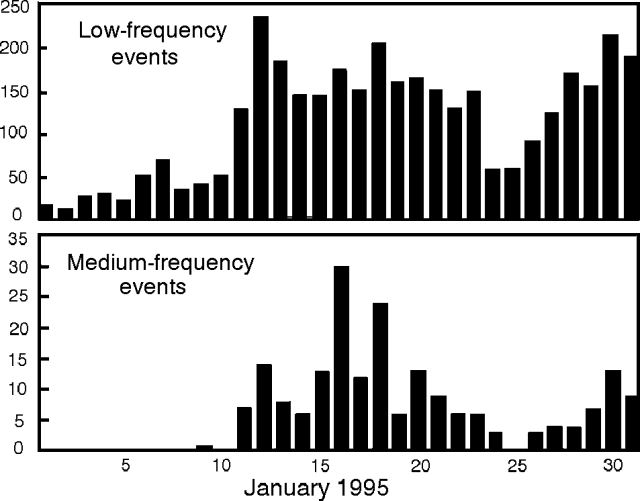Report on Poas (Costa Rica) — January 1995
Bulletin of the Global Volcanism Network, vol. 20, no. 1 (January 1995)
Managing Editor: Richard Wunderman.
Poas (Costa Rica) January seismicity highest in five months
Please cite this report as:
Global Volcanism Program, 1995. Report on Poas (Costa Rica) (Wunderman, R., ed.). Bulletin of the Global Volcanism Network, 20:1. Smithsonian Institution. https://doi.org/10.5479/si.GVP.BGVN199501-345040
Poas
Costa Rica
10.2°N, 84.233°W; summit elev. 2697 m
All times are local (unless otherwise noted)
Fumarolic activity continued at Poás in the reestablished crater lake. OVSICORI-UNA reported that in January the lake had a temperature of 50°C, a turquoise-green color, and its level dropped by 40 cm with respect to December. During January evaporative clouds rose to as high as 50 m above the lake. The N part of the dome continued to slide. No significant changes were registered by study of either leveling lines, dry tilt, or the distance measuring network over the crater surface.
During January, low- and medium-frequency earthquakes took place more often than in the five previous months (table 6). As partly summarized in 19:11, during 1994 low-frequency earthquakes peaked in March (7,118 events), medium-frequency earthquakes peaked in June (556 events), and high-frequency earthquakes peaked in August (31 events). The greatest number of seismic events took place on 12 January in the low-frequency range, and on 16 January in the medium-frequency range (figure 57).
Table 6. Poás seismic data, January 1994-August 1995 (from the station POA2, located 2.7 km SW of the active crater). Frequency ranges are as follows: low (<2 Hz), medium (2.1-3.0 Hz), high (>3 Hz). Courtesy of OVSICORI-UNA.
| Month | Low-frequency | Medium-frequency | High-frequency | Hours of Tremor |
| Jan 1994 | 4,040 | 94 | 0 | -- |
| Feb 1994 | 4,786 | 59 | 0 | -- |
| Mar 1994 | 7,118 | 114 | 0 | -- |
| Apr 1994 | 6,916 | 23 | 7 | -- |
| May 1994 | 5,336 | 99 | 9 | -- |
| Jun 1994 | 5,472 | 556 | 1 | -- |
| Jul 1994 | 4,994 | 374 | 15 | -- |
| Aug 1994 | 3,639 | 102 | 31 | -- |
| Sep 1994 | 1,524 | 31 | 24 | -- |
| Oct 1994 | 3,630 | 88 | 0 | -- |
| Nov 1994 | 3,563 | 91 | 1 | -- |
| Dec 1994 | 2,539 | 14 | 2 | -- |
| Jan 1995 | 4,347 | 198 | 0 | 0 |
| Feb 1995 | 4,710 | 207 | 20 | 0 |
| Mar 1995 | 6,881 | 113 | 1 | 0 |
| Apr 1995 | 5,798 | 367 | 2 | 11 |
| May 1995 | 3,142 | 715 | 0 | 5 |
| Jun 1995 | 2,258 | 322 | 28 | 0 |
| Jul 1995 | -- | -- | -- | -- |
| Aug 1995 | 5,486 | 165 | 0 | 9 |
 |
Figure 57. Low- and medium-frequency earthquakes at Poás during January 1995. Courtesy of OVSICORI-UNA. |
Geological Summary. The broad vegetated edifice of Poás, one of the most active volcanoes of Costa Rica, contains three craters along a N-S line. The frequently visited multi-hued summit crater lakes of the basaltic-to-dacitic volcano are easily accessible by vehicle from the nearby capital city of San José. A N-S-trending fissure cutting the complex stratovolcano extends to the lower N flank, where it has produced the Congo stratovolcano and several lake-filled maars. The southernmost of the two summit crater lakes, Botos, last erupted about 7,500 years ago. The more prominent geothermally heated northern lake, Laguna Caliente, is one of the world's most acidic natural lakes, with a pH of near zero. It has been the site of frequent phreatic and phreatomagmatic eruptions since an eruption was reported in 1828. Eruptions often include geyser-like ejections of crater-lake water.
Information Contacts: Erick Fernández, Jorge Barquero, Rodolfo Van der Laat, Franklin de Obaldia, Tomás Marino, Vilma Barboza, and Rodrigo Sáenz, Observatorio Vulcanológico y Sismológico de Costa Rica, Universidad Nacional (OVSICORI-UNA), Apartado 86-3000, Heredia, Costa Rica; Gerardo J. Soto, Oficina de Sismología y Vulcanología, Departamento de Geología, Instituto Costarricense de Electricidad (ICE), Apartado 10032-1000, San José, Costa Rica.

